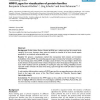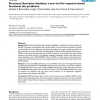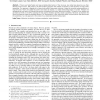35 search results - page 3 / 7 » Graphical Models of Residue Coupling in Protein Families |
BMCBI
2004
13 years 4 months ago
2004
Background: G protein-coupled receptors (GPCRs) transduce signals from extracellular space into the cell, through their interaction with G proteins, which act as switches forming ...
BMCBI
2004
13 years 4 months ago
2004
Background: Profile Hidden Markov Models (pHMMs) are a widely used tool for protein family research. Up to now, however, there exists no method to visualize all of their central a...
BMCBI
2008
13 years 5 months ago
2008
Background: The Structural Descriptor Database (SDDB) is a web-based tool that predicts the function of proteins and functional site positions based on the structural properties o...
CIBCB
2005
IEEE
13 years 10 months ago
2005
IEEE
- Establishing structure-function relationships on the proteomic scale is a unique challenge faced by bioinformatics and molecular biosciences. Large protein families represent nat...
VIS
2007
IEEE
14 years 6 months ago
2007
IEEE
Proteins are highly flexible and large amplitude deformations of their structure, also called slow dynamics, are often decisive to their function. We present a two-level rendering ...



